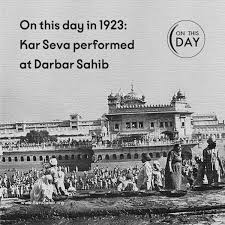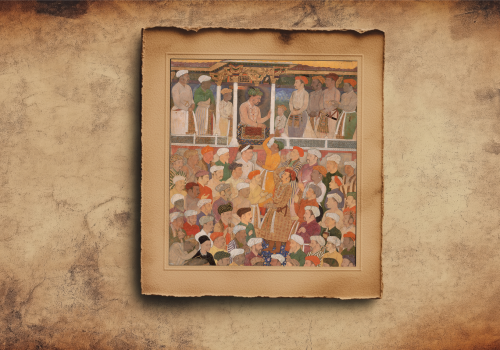KARSEVA, the voluntary contribution of physical labor towards cleaning and construction operations at sacred tanks and temples, holds special significance in the Sikh tradition. SEVA, or altruistic service, was preached by the Gurus as a means to God-realization. “One who renders selfless service attains to the Lord’s presence,” says the Scripture (GG, 286-87).
KARSEVA may be interpreted in two ways. In Sanskrit, as well as in Persian, the word means simply act, action, work, operation, labor, or service, so that KARSEVA may mean any physical act, labor, or service altruistically performed. However, in Sikh usage, the term is applied to free voluntary labor contributed to building, repairing, or renovating projects undertaken by the community. In another and more popular sense, until recently, the word KARSEVA was taken as derived from the Arabic (y’artr), meaning “to go to the bottom, to make deep, bottom, or depth (of a well, etc.).” KARSEVA is thus applied specifically to the work of dredging or removing, by manual labor, sedimentary mud and garbage collected at the bottom of a sarovar, sacred pool, or tank, over the years.
Sikhs—male and female, old and young, high and low—consider it a privilege to participate in KARSEVA. Therefore, in order to give the maximum number of people a chance to take part, it is customary not to use mechanical contrivances, but instead simple digging implements and baskets during the operation.
The inauguration of the work is marked by a solemn ceremony. Panj Piara, or the Five Elect, are chosen for their eminence in piety. They, after ARDAS (a supplicatory prayer to God for assistance in the successful completion of the task), offered in the presence of gathered volunteers, dig the first clods and carry them in baskets on their heads up to the banks of the sarovar amidst the singing of sacred hymns.
The volunteers then take over, and the whole tank hums with activity, accompanied by hymns singing or the simple, sonorous repetition of “Sat Nam Vahiguru”—”God, whose very name is the Truth.” As the operations conclude, the sarovar is refilled with fresh water, and a thanksgiving Ardas is offered. Sikh chronicles describe the KARSEVA operations at the Pool of Nectar, the sacred tank of Amritsar—which lent its name to the city—on several occasions. This sarovar was initially dug by Guru Ram Das (1534–1581).
Being unlined and rain-fed, it soon started to become shallow. Guru Arjan (1563–1606) undertook the first KARSEVA, which involved not only deepening but also brick-lining its banks with steps leading down. He also had the Harimandar constructed in the middle of it, along with the causeway connecting the shrine to the bank. This project, extending over several years, was executed primarily with voluntary, free labor.
With the shifting of the Guru’s seat to Kiratpur and Chakk Nanaki in the Shivalik foothills, no KARSEVA at Amritsar is recorded to have taken place for over a century. In 1746, Lakhpat Rai, Diwan (revenue minister) to Yahiya Khan, governor of Lahore, launched a severe campaign of persecution against the Sikhs in retaliation for the death of his brother, Jaspat Rai, at their hands in an encounter. Besides inflicting heavy casualties on the Sikhs in what is known as Chhota Ghallughara (the Minor Holocaust), he destroyed their shrines and had the Pool of Nectar partly filled up.
However, the following year, Sikhs regained control of Amritsar and had the sarovar cleaned through KARSEVA. The sarovar was filled up again in May 1757 by Jahan Khan, an army commander and deputy viceroy of Punjab under Taimur Shah, son of Ahmad Shah Durrani. Taimur and Jahan Khan were, however, driven out of Punjab in April 1758 by a combined force of Sikhs and Marathas, and the Sikhs once again had the sarovar cleaned by two hundred Afghan prisoners of war. Sikh volunteers also assisted in the KARSEVA.
Five years later, on the eve of Baisakhi in 1762, Ahmad Shah Durrani, not content with the crushing blow he had inflicted upon the Sikhs two months earlier during what is known in Sikh history as Vadda Ghallughara (the Greater Holocaust), suddenly fell upon Amritsar. He blew up the Harimandar with gunpowder and filled the Pool of Nectar with debris and rubbish. Dal Khalsa, the fighting force of the Sikhs, under Jassa Singh Ahluwalia, retaliated with an attack on Sirhind in May 1762. Zain Khan, the faujdar (commandant), was defeated and purchased peace with Rs 50,000 as indemnity to the Sikhs. Following their advantage, the Sikhs reoccupied Amritsar in October 1762.
Durrani’s one attempt to eject them on Diwali day, 17 October, was frustrated, and the Sikhs were left free to perform the KARSEVA at the sacred tank in peace. In January 1764, the Sikhs conquered Sirhind. The accursed town was put to systematic destruction and pillage, and it was decided to set apart a major part of the plunder for the reconstruction of the Harimandar, along with the embankment and circumambulatory terrace around the sarovar. The execution of the project was entrusted to Bhai Des Raj and was completed in 1776.
The next KARSEVA was carried out in 1842 under the supervision of Bhai Gurmukh Singh Giani. Eighty-one years later, in 1923, the newly established Shiromani Gurdwara Parbandhak Committee planned another KARSEVA. As a preparatory measure, an earthen embankment temporarily divided the sarovar into two parts. The water of one part was transferred into the other so that the emptied half could be prepared for digging and deepening.
The actual operations were inaugurated with great fanfare on 17 June 1923. Panj Piare, including Sant Sham Singh of Amritsar, Sant Gulab Singh of Gholia, Jathedar Teja Singh of Chuharkana, Sodhi Pritam Singh of Anandpur Sahib, and Sardar Mahitab Singh, came to the Harimandar at the head of a large procession. Five gold shovels and five large silver bowls were placed at Har ki Pauri. After offering Ardas (a prayer), the Panj Piare each lifted a shovel and bowl, dug some sedimentary clods from the emptied half of the sarovar, and carried them in the bowls up the embankment stairs to throw them beyond the terrace.
Volunteers, assembled district-wise, took turns at seva. Even Maharaja Bhupinder Singh, ruler of Patiala (1891–1938), and other Sikh chiefs participated in this sacred labor. The latest KARSEVA at Amritsar was in 1973. This time, the Panj Piare included five eminent saints known for their dedication to renovating Sikh shrines at various locations.
They were Sant Gurmukh Singh, Sant Kharak Singh, Sant Jivan Singh, Sant Seva Singh, and Sant Mohindar Singh. The dredging of the sacred tank at Tarn Taran, the largest of the Sikh sarovars, was carried out from 10 January 1931 to 31 May 1932. Building activities through KARSEVA continue at various places throughout the country, keeping the Sikh tradition of seva alive and inculcating values such as equality, humility, and the dignity of manual labor among the followers of the faith.
- References:
- Pratap Singh, Giani. Gurdwara Sudhar Arthat Akali Lahir. Amritsar, 1975.
- Gian Singh, Giani. Twarikh Sri Amritsar. Amritsar, 1977.
- Madanjit Kaur. The Golden Temple: Past and Present. Amritsar, 1983.
- Fanja Singh. The City of Amritsar. Delhi, 1978.
More Information:
‘Kar Sewa’ means work for humanity with devotion. The word ‘Kar Sewa’ is used for a pure task without any greed or lust or egoism, it is Service done with devotion, honesty, faith and with spirit of sacrifice, it may be any noble task done for mankind with due respect and faith in one God.
Sikhism has a long and distinguished history of sacrifices, and unconditional service (Sewa) is integral to it’s principles and tenets. Baba Budha Ji (born in 1506) was the first Kar Sewak amongst Sikhs, who with the blessings of Guru Nanak Dev Ji, spent his whole life of over 100 years in Kar Sewa. Sri Guru Hargobind Sahib Ji entrusted Kar Sewa of constructing Sri Akal Takht Sahib at Amritsar to Baba Budha Ji.
It is the fundamental duty of every Sikh to follow the ‘Path of Kar Sewa’ shown by Baba Budha Ji, Bhai Gurdas ji and all Sikh Gurus. Sikh history is full of devoted Kar sewaks. Notable among them was Sant Baba Biram Dass ji who spent most of his life doing Kar Sewa. The love for humanity and the spirit of Sewa took Baba Gurmukh Singh ji and his cousin Baba Sadhu Singh to Kar Sewak Biram Dass ji, who preached them to follow the path of Sewa and saved them from the binding ties of the materialistic world.
Both Baba Gurmukh Singh ji and Baba Sadhu Singh ji lived their lives exactly as per their names ‘Gurmukh’ and ‘Sadhu’ respectively. Both brothers came to Amritsar on command of Baba Biram Dass ji and started Sewa of cleaning Parikarma of Sri Darbar Sahib, while reciting name of God as, ‘Satnam Waheguru-Satnam Waheguru’. Baba Gurmukh Singh ji revived the institution of Kar Sewa, with its epicenter at ‘Dera Kar Sewa’. After his demise in 1948, Baba Gurmukh Singh ji was succeeded by Baba Jiwan Singh Ji till 1974, and Baba Dalip Singh ji, Baba Jhanda Singh Ji and Baba Hari Singh Ji continued to perform Kar Sewa with firm devotion. During his life time, Baba Hari Singh Ji appointed Baba Jagtar Singh Ji as the head of Dera Kar Sewa, Tarn Taran.
Since, then Baba Jagtar Singh Ji has been performing Kar Sewa at various places with cooperation of Sikh sangat of the country and abroad. Nearly, 25 Jathedars (leading men) have been distributed with various Kar Sewa tasks at different places in India including Sikh shrines of Pakistan. Baba Mohinder Singh Ji is the cashier of the Dera, who looks after expenses and records of the Dera.
All the Kar Sewas are being carried under his supervision as well as that of Sadh Sangat, and full cooperation of Shiromani Gurdwara Parbhandhak Committee, Amritsar and Delhi Sikh Gurdwara Management Committee. With the mutual cooperation and advice of such institutions, the mission of Kar sewa is being carried out smoothly.







